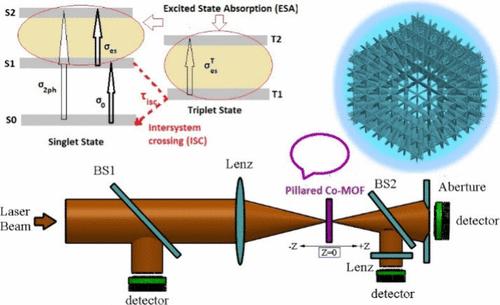An Amide-Functionalized Pillar-Layered Metal–Organic Framework Based on Mixed Linker Systems with Enhanced Third-Order Nonlinear Optical Performance
IF 4.7
2区 化学
Q1 CHEMISTRY, INORGANIC & NUCLEAR
引用次数: 0
Abstract
The development of novel nonlinear optical (NLO) materials is increasingly focused on crystal structures that offer both high efficiency and laser damage thresholds, particularly for appliances in optical switching and communications. Herein, an experimental inquiry is described into the third order NLO response of an amide-functionalized pillar-layered metal–organic framework (MOF) encompassing cobalt ions and 4,4′-oxybis(benzoic acid) and N,N′-bis(4-pyridylformamide)-1,4-benzenediamine linkers. The introduced MOF possesses a complex porous structure defined by a 3,4,5T94 topology. The π-conjugated structure and nitrogen-containing derivatives with lone electron pairs on the nitrogen atoms endow this MOF with strong intramolecular charge-transfer capabilities, thereby facilitating the formation of donor–acceptor molecules. The pillared Co-MOF offers a significant nonlinear optical profile, with an NLR index (n2) at a range of (6.6–19.1) × 10–8 cm2/W and an NLA coefficient (β) of (2.92–14.27) × 10–3 cm/W. The rationale explanation for the NLO response in pillared Co-MOFs, could be d–d transitions of Co2+ ions, π–π and LMCT/MLCT transitions, charge-transfer interactions between metal nodes and organic linkers, structural anisotropy, and pillar-induced electron delocalization. The Z-scan findings highlight the potential of the pillared MOFs with mixed ligands as promising alternatives for photonics devices, optical switches, and optical power-limiting technologies.

基于三阶非线性光学性能增强的混合连接体系的酰胺功能化柱层金属-有机骨架
新型非线性光学(NLO)材料的发展越来越多地集中在提供高效率和激光损伤阈值的晶体结构上,特别是在光交换和通信中的应用。本文研究了含钴离子、4,4′-氧双(苯甲酸)和N,N′-双(4-吡啶甲酰胺)-1,4-苯二胺连接剂的酰胺功能化柱状层状金属有机骨架(MOF)的三阶NLO响应。引入的MOF具有由3,4,5 t94拓扑定义的复杂多孔结构。π共轭结构和氮原子上具有孤电子对的含氮衍生物使该MOF具有较强的分子内电荷转移能力,从而有利于供体-受体分子的形成。柱状Co-MOF提供了显著的非线性光学轮廓,NLR指数(n2)在(6.6-19.1)× 10-8 cm2/W范围内,NLA系数(β)为(2.92-14.27)× 10-3 cm/W。柱状co - mof中NLO响应的基本原理可以解释为Co2+离子的d-d跃迁、π -π和LMCT/MLCT跃迁、金属节点和有机连接体之间的电荷转移相互作用、结构各向异性和柱状诱导的电子离域。z扫描结果强调了混合配体的柱状mof作为光子器件、光开关和光功率限制技术的有前途的替代品的潜力。
本文章由计算机程序翻译,如有差异,请以英文原文为准。
求助全文
约1分钟内获得全文
求助全文
来源期刊

Inorganic Chemistry
化学-无机化学与核化学
CiteScore
7.60
自引率
13.00%
发文量
1960
审稿时长
1.9 months
期刊介绍:
Inorganic Chemistry publishes fundamental studies in all phases of inorganic chemistry. Coverage includes experimental and theoretical reports on quantitative studies of structure and thermodynamics, kinetics, mechanisms of inorganic reactions, bioinorganic chemistry, and relevant aspects of organometallic chemistry, solid-state phenomena, and chemical bonding theory. Emphasis is placed on the synthesis, structure, thermodynamics, reactivity, spectroscopy, and bonding properties of significant new and known compounds.
 求助内容:
求助内容: 应助结果提醒方式:
应助结果提醒方式:


